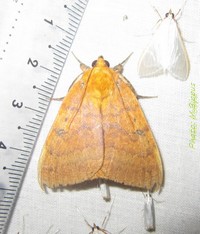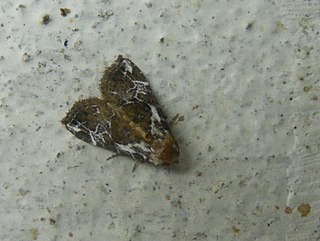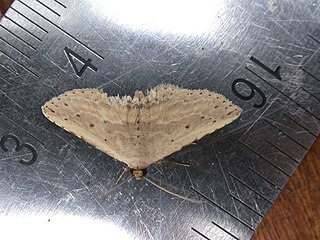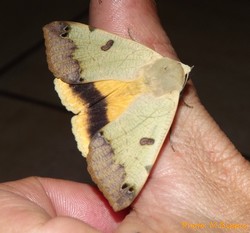Lobobasis is a monotypic moth genus in the family Erebidae. Its single species, Lobobasis niveimaculata, is found from the Indian state of Sikkim, Bhutan and Sundaland to Queensland, the Solomon Islands and New Guinea. The habitat consists of lower montane forests, upper montane forests and various types of lowland forests. Both the genus and species were first described by George Hampson in 1896.
Neoduma is a genus of moths in the subfamily Arctiinae. The genus was erected by George Hampson in 1918.
Omiosia is a monotypic moth genus in the subfamily Arctiinae erected by George Hampson in 1900. Its single species, Omiosia fuscipennana, was first described by Francis Walker in 1863. It is found on Borneo. The habitat consists of lowland forests.
Pseudoscaptia is a monotypic moth genus in the family Erebidae erected by George Hampson in 1914. Its only species, Pseudoscaptia rothschildi, was first described by Max Wilhelm Karl Draudt in 1912. It is found in the north-eastern Himalayas, Vietnam, Thailand, as well as on Malacca, Sumatra, Java and Borneo. The habitat consists of lowland forests, including secondary forests.

Achaea is a genus of moths in the family Erebidae described by Jacob Hübner in 1923.

Chorsia is a genus of moths of the family Erebidae. The genus was erected by Francis Walker in 1863.

Eublemma is a genus of moths of the family Erebidae described by Jacob Hübner in 1829.

Hyposada is a genus of moths of the family Erebidae.

Ophiusa is a genus of moths in the family Erebidae erected by Ferdinand Ochsenheimer in 1816.

Xenochroa xanthia is a moth of the family Nolidae first described by George Hampson in 1902. It is found in the north-eastern parts of the Himalayas, Singapore, Sumatra, Borneo and Palawan. It is found in lowland forests.
Bosara emarginaria is a moth in the family Geometridae first described by George Hampson in 1893. It is found on Borneo and in Sri Lanka, the north-eastern Himalayas and Hong Kong. The habitat consists of lowland dipterocarp forests.
Glaucoclystis griseorufa is a moth in the family Geometridae. It is found in the north-eastern Himalayas and on Peninsular Malaysia and Borneo. The habitat consists of lowland forests.

Asura fulguritis is a lichen moth of the family Erebidae, subfamily Arctiinae. The species was first described by George Hampson in 1900. It is found on Bali, Java, Sumatra, Pulo Laut, Borneo and Peninsular Malaysia. The habitat consists of lowland and lower montane forests.
Holocraspedon bilineata is a moth of the family Erebidae first described by George Hampson in 1901. It is found in Singapore, Thailand and the north-eastern Himalayas, as well as on Peninsular Malaysia, Borneo, Sulawesi and Sumbawa. The habitat consists of lowland forests and wet heath forests.
Eutane nivea is a moth of the subfamily Arctiinae. It was described by George Hampson in 1905. It is known to originate from Borneo. The habitat consists of lowland forests, including coastal and swamp forests.
Heliosia monosticta is a moth of the family Erebidae. It was described by George Hampson in 1900. It is found on Borneo. The habitat consists of lowland forests, dry heath forests and coastal scrubs.

Meteugoa ochrivena is a moth of the family Erebidae. It was described by George Hampson in 1898. It is found in the north-eastern Himalayas, Taiwan and on Borneo and Bali. The habitat consists of lower montane forests, hill dipterocarp forests and lowland forests.

Tortricosia excisa is a moth in the subfamily Arctiinae first described by George Hampson in 1900. It is found in Myanmar, Peninsular Malaysia and Borneo. The habitat consists of lowland forests, including heath forests and disturbed areas.
Spilarctia hypogopa is a moth in the family Erebidae. It was described by George Hampson in 1907. It is found on Peninsular Malaysia, Sumatra and Borneo. The habitat consists of lowland forests and secondary vegetation.
Utriculofera fuscapex is a moth in the subfamily Arctiinae. It was described by George Hampson in 1893. It is found in Sri Lanka and India, as well as on Borneo. The habitat consists of lowland forests.









